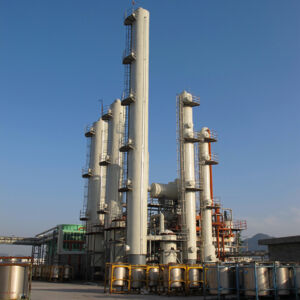DMSO Recovery Process

Dimethyl sulfoxide (DMSO) is a versatile solvent used in numerous industrial and laboratory applications, including as a cryoprotectant in biological preservation and as a reagent in organic synthesis. Due to its significant uses, recovering DMSO after use becomes important for reducing waste and cost. Below is a typical process for DMSO recovery, especially when dealing with large-scale or industrial applications:
- Initial Separation: After DMSO is used in processes or reactions, it often contains contaminants, residual solvents, or other by-products. The first step in the recovery process involves separating DMSO from solid waste or insoluble materials, which can be done through filtration, centrifugation, or decantation, depending on the nature of the contaminants.
- Distillation: Once the bulk contaminants are removed, distillation is the most common technique used for DMSO recovery. DMSO has a relatively high boiling point (189°C), which makes it suitable for distillation in systems designed for higher temperatures. Fractional distillation can be used to separate DMSO from other solvents or residual substances with different boiling points. During the distillation process, it is crucial to control the temperature carefully to avoid the decomposition of DMSO or other heat-sensitive compounds.
- Solvent Extraction: In cases where distillation alone is not sufficient or practical, solvent extraction methods can be employed. A solvent with a different polarity than DMSO is chosen to selectively extract impurities while leaving the DMSO relatively pure. After separation, the solvent can be evaporated, leaving behind the recovered DMSO.
- Adsorption/Filtration: For DMSO that is contaminated with organic compounds or colored impurities, activated charcoal or other adsorbent materials can be used to remove these impurities. Filtration through a fine mesh or membrane might also be required to remove particulate matter or other fine contaminants.
- Recrystallization (in special cases): If the DMSO has been contaminated with high-boiling or polar materials, recrystallization can be performed to purify the solvent. This is generally more useful in laboratory-scale processes and might not be as effective or efficient in industrial applications due to the large volumes involved.
- Drying: DMSO is hygroscopic, meaning it can absorb moisture from the air, which may reduce its effectiveness as a solvent. After the recovery process, the purified DMSO is often dried using anhydrous materials like sodium sulfate or by distilling it over drying agents under reduced pressure.
- Recycling and Reuse: Once purified, the recovered DMSO can be reused in laboratory experiments or industrial processes. The solvent’s high stability and ability to dissolve both polar and non-polar substances make it a valuable resource that can be continuously recycled through these recovery processes. However, careful monitoring of the DMSO’s purity after recovery is necessary to ensure it meets the requirements for reuse.
- Environmental Considerations: In large-scale applications, the disposal of waste products and contaminants after DMSO recovery must be handled responsibly to minimize environmental impact. The recovery system should ensure that by-products are either neutralized or safely disposed of according to regulatory standards.
In conclusion, the recovery of DMSO is an important process to ensure its sustainability and minimize waste. Using techniques such as distillation, solvent extraction, filtration, and drying, DMSO can be efficiently purified and reused, contributing to cost savings and environmental protection.

